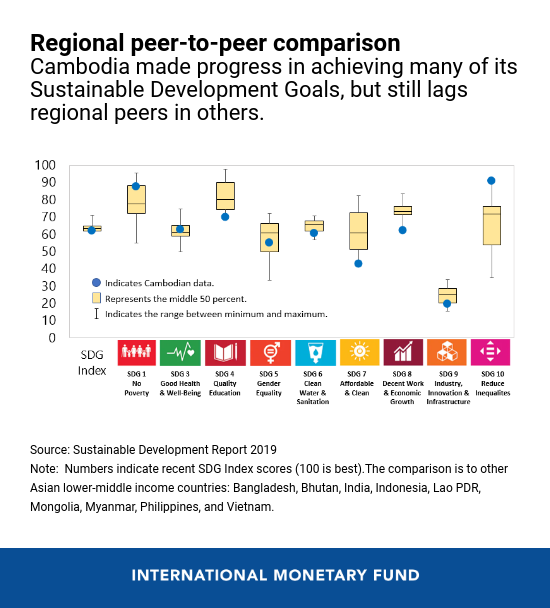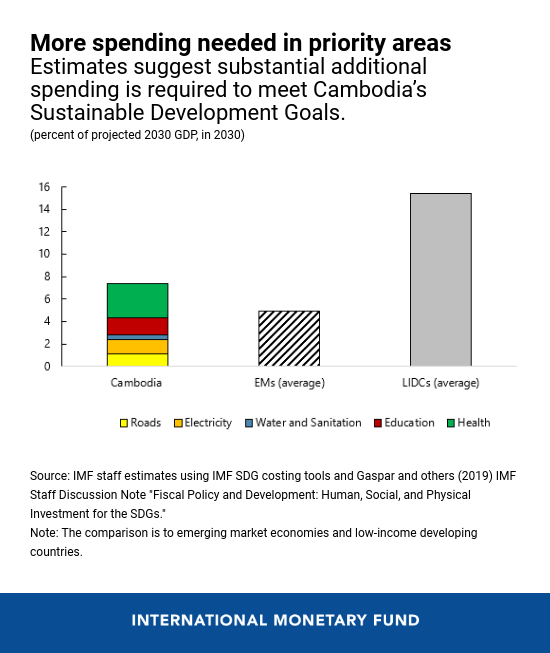
Young Cambodian students taking English lessons. Cambodia’s primary school enrollment rate is nearly 100%, a result of increased public spending on education in the country. (photo: Yongyuan Dai/istock photos)
Cambodia: Fiscal Policies Can Further Boost Sustainable Development
December 27, 2019
Cambodia continues to rank among the fastest growing economies in Southeast Asia and has made significant progress toward meeting its development goals. To underpin further progress, the country would need to channel additional spending into priority sectors like education, health, and physical infrastructure in the context of a sustainable financing plan.
Related Links
Efforts would need to continue to improve spending efficiency, public investment management practices, and coordination across government units. Support from development partners and involvement of the private sector are also essential.
Cambodia’s economic growth remains strong at 7 percent in 2019 and the country continues to advance its development agenda, according to the IMF’s latest economic assessment.
Public investment and private sector involvement resulted in improved access to and quality of physical infrastructure, such as electricity and roads. Public spending on health and education also increased, which led to improved quality and access. As a result, for example, the enrollment rate in primary education has reached almost 100 percent.
Cambodia continues to prioritize the Sustainable Development Goals (SDGs) by mapping them (along with one additional goal related to de-mining) into the country’s national policy priorities. The new government’s strategy reflects Cambodia's SDG framework and is the basis for the National Strategic Development Plan for 2019–23.
Still, the country’s ambitious development plans will require further policy efforts on many fronts. Despite recent progress, Cambodia lags behind its regional peers in terms of access to and quality of social services and physical infrastructure.

Estimates suggest that more spending is required to meet selected SDGs and improve the daily lives of all Cambodians. The quantity and quality of health and education services, as well as physical infrastructure, need to be improved.
IMF staff estimate that additional spending of about 7½ percent of Cambodia’s 2030 GDP is needed to help fund priority SDGs, with education and health accounting for about two-thirds of the total needs. While spending needs for reaching water and sanitation goals are smaller, achieving universal access to electricity and roads would require additional annual spending of at least 2½ percent of projected 2030 GDP. These estimates account partially for climate mitigation policies (such as an increase in the use of solar energy to generate electricity) and maintenance costs.

Policy action
Well-designed fiscal policies can help support Cambodia’s development goals. Additional spending on education, health, and infrastructure—in line with national strategic priorities—will support progress towards the country’s SDGs. Improvements in spending efficiency and public investment management practices—including through better coordination across government units—will be essential.
To help finance the spending needs without taking on high levels of public debt, efforts would need to continue to further mobilize domestic revenue. The government could also partially draw down its deposits, borrow at concessional terms, and bring in development partners and the private sector where feasible.
In addition to improving social services and infrastructure, also topping the list of priorities is to continue improving environmental sustainability. This includes climate mitigation policies—by moving, for instance, more towards renewable sources of energy—and the country’s natural disaster and climate change preparedness.


